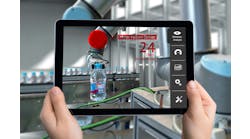The radio-frequency identification (RFID) tracking and error-proofing functions, typically used in machines, can often be replaced with other methods such as sensors, work procedures and barcode readers. However, RFID sure has created many niches over the past 50 years. For many years now, the 1-bit RFID anti-theft tag has been tracking anything that needed tracking. The machine builder and OEM have many options in RFID today. The basics require proper selection of tag and reader for the application and integration into the control system.
So, about 30 years ago, I read an article about the demise of the barcoded products, specifically called the universal product code (UPC), and the rise of the intelligent radio frequency identification (RFID) tags. Well, I recently read an RFID article, and that dream still lives 30 years later. Maybe it will happen when the RFID approaches the cost of the UPC, but, even at a higher cost, there are many uses for RFID today.
An RFID system consists of the scanning antenna, which sends the radio frequency (RF) signal to both power and communicate with the RFID tag; the transceiver or processor, which sends and decodes data; and the transponder, which is the data carrier tag.
The RFID tag is similar to a barcode, providing a unique identifier for the part or device, but it's smarter with the ability to have read/write data stored on it. The data is written or read via a noncontact method using RF. A PC or PLC communicates with the RFID processor, using a variety of popular protocols, allowing tags to be programmed—written with data—and read to pass data to the control system or data collection system. A handheld RFID interface is also available to read and program the RFID tags. These are often manufacturer-specific so beware.
RFID tags can be active or passive. The active RFID tags have their own power source, which can extend the signal range. It also limits their lives. The passive RFID tags are power by the transceiver's RF signal, which enables long life, and the tag can be much smaller, having shrunk to just an antenna and a single-chip integrated circuit. It also reduces their read/write signal effective distance.
Selection and application
When selecting an RFID system there are many choices. From cost, frequency and sensing range to data storage and read/write capabilities, too many choices and competing standards or lack of standards has been an issue in the past. Check out the RFID vendors, but make your decision based on the application and standard products.
Cost is a big factor. Until the cost of RFID matches the cost of a barcode, the barcode will be a better choice in many applications. With U.S. manufacturing jobs going overseas to save a few cents, adding $0.10 or much more to the cost of a product by adding an RFID tag is tough to justify.
Over the years, the scanning frequency has varied and still does. Low frequencies starting at 70 kHz; high frequencies starting at approximately 560 kHz; and ultra-high frequencies starting around 900 MHz are available. The vendors can tell you about the advantages. Physical, environmental and RFID tag read distances are big factors.
RFID has varied storage capabilities. From a low end of 16 to 32 alpha-numeric characters up to 128 KB of data can be read and stored on each tag. Data storage does affect cost though, and it adds to the complexity of the application when reading, using and writing the data. Also, although there are typically a limited number of data writes,
RFID has several benefits. The most notable is the ability to track the who, what, when and where information directly on the product or device. Large amounts of data can be stored. However, this does seem less necessary at the IoT is enabling the use of just a serial number to identify the product with all the specific product data stored and available on the Internet. Stay local or get connected, or maybe both.
It is not necessary to accurately position the RFID scanner antenna to the tags. This is a concern with barcode readers. With RFID, the sensing range is several inches to 20 ft or more, depending on the scanner and tag used. And many RFID tags can read at the same time.
Who knows if RFID will ever replace the barcode or similar tracking methods? However, RFID is suitable for a wide variety of applications from the plant floor, up close and personal at the assembly process, to the warehouse and on to the door of you favorite big-box discount store. RFID can track work in process, inventory, assets and products, and it can even track you if embedded into wearables.
Take advantage of all the information online about RFID and consider it for a variety of applications.Tracking pallets on a conveyor and automobile chassis on an assembly line are good applications. A box full of tooling, products or core samples could be counted and tracked, as well, without touching a thing. Some vendors even use it for anti-tamper safety interlocks. Learn the basics and integrate RFID into your automation.
ALSO READ: Sensors and vision 2015 State of Technology ebook
Homepage image courtesy of Grika on Wikipedia [CC BY 2.5 (http://creativecommons.org/licenses/by/2.5)], via Wikimedia Commons






